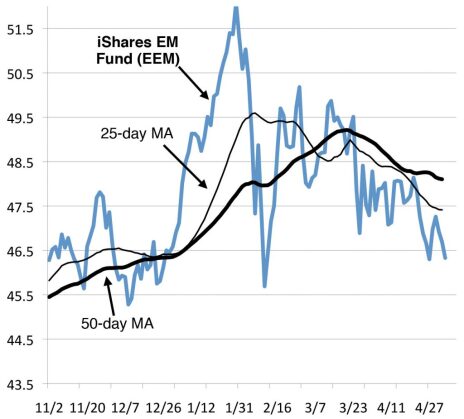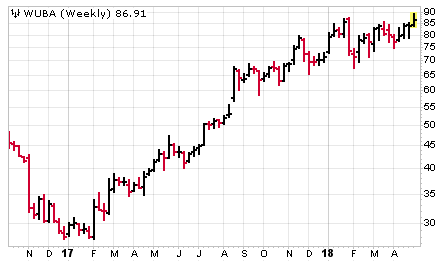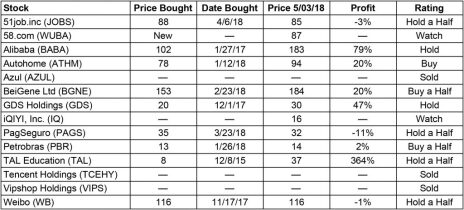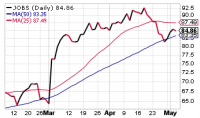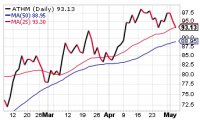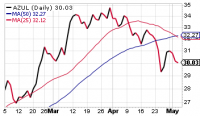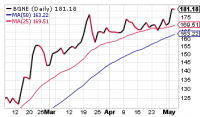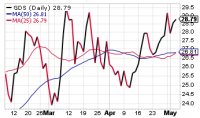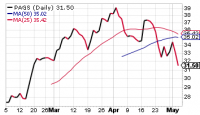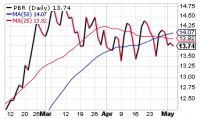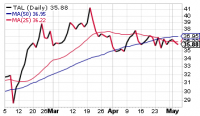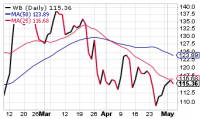The intermediate-term trend in emerging market stocks remains down, and we continue to advise a substantial degree of caution. At the same time, the fact that the indexes (both emerging markets and domestic) have been able to hold above their February lows means there’s a chance that a renewed advance can begin at any time. But we won’t predict; we’ll just follow the market’s lead, while keeping you apprised of the action in the highest potential emerging markets stocks we can find. Today we add another name to the watch list; it’s an old friend that just hit a new high a couple of days ago.
Cabot Emerging Markets Investor 658
[premium_html_toc post_id="149575"]
Cabot Emerging Markets Timer
The Emerging Markets Timer is our disciplined method for staying on the right side of the emerging markets. The Timer is bullish when the index is above the lower of its two moving averages and that moving average is trending up.
Our Emerging Markets Timer remains negative, a sign to remain cautious as we patiently wait for the bulls to return. Like most U.S. indexes, the iShares EM Fund (EEM) has held its correction lows and done more chopping than declining during the past month, but it’s still meandering below its still-declining lower (25-day) moving average. Thus, the intermediate-term trend is still down.
From here, though, we’re open to anything. Believe it or not, two or three good days could actually flip the trend (a move above 48 or so could do the trick), but the onus is clearly on the bulls—until proven otherwise, it’s best to hold plenty of cash and work on building a watch list of potential new leaders of the next upturn.
Market Trends and Globalization
If you were so inclined, you could spend all day seeking out expert opinions on China, Korea, Brazil, India and Russia, and at the end of the day you’d have a lot of opinions—but you wouldn’t necessarily be any wiser. In fact, you might just be more confused, particularly because so many experts tend to conflate their analyses with their personal opinions about the political issues in these places. (And Lord knows, there are a lot of political opinions substituting for rational thinking these days!)
Knowing that, here at Cabot, we’ve learned to keep it simple, and our formula for success boils down to this: listen to the market carefully, invest in uptrends, conserve cash in downtrends, and focus on owning the stocks of companies with great growth prospects.
But what indexes are best to monitor these uptrends? And how do you define an uptrend?
Interestingly, thanks in part to globalization, our favorite emerging markets exchanges have been trading pretty much in sync with the major domestic exchanges over the past year. (For the record, we follow PowerShares Golden Dragon (PGJ), iShares MSCI Emerging Markets ETF (EEM) and Halter USX China Index (HXC).) So at the moment, there’s not much point in differentiating between the two groups. And there’s good and bad in this. The good is that it makes the analysis easier overall; the bad is that if global markets turn down en masse from here, there may be nowhere to hide.
Turning to timeframes, therefore, what follows pretty much applies to all the relevant indexes.
If you step back and look at a chart of the market over the last decade, the uptrend is clear. And if you just look at the past year it’s still clear. But as you zoom in to the past six months, and then the past three months, the uptrend becomes suspect. In fact, it becomes worthy of close examination.
The most striking feature is the initial selloff that kicked off from a record high in late January and lasted two weeks, taking most indexes down close to—or even through—their 200-day moving averages. That was followed by a month-long rebound that recovered more than half the previous loss (the Nasdaq Composite being the upside outlier), but then the market rolled over again, taking the indexes down close to—but not as low as—their February lows. Since then we’ve had one more rally and one more rollover, with all indexes holding above their February lows.
In essence, this is the same pattern you get when you drop a ball on the floor and let it bounce; with each bounce, the ball’s maximum height decreases until the ball finally rests on the floor—or rolls away.
Trouble is, in the stock market there is no floor, so it’s quite possible that the ball—generally when you least expect it—finds its way to the cellar stairs and plunges merrily downward!
That, in fact, is the scenario that’s most likely today, which is why we took the initial sell signals from our indicators seriously, and why we continue to hold a hefty 40% cash position today.
But the future is not certain! So we continue to listen closely to the messages broadcast by all the market indexes as well as individual stocks, and if the indexes continue to find support at or above their February lows (a sign that big investors are accumulating there), that level could eventually serve as a launching pad for the next major upleg of this 10-year-old bull market.
Bottom line: as the market again tests the lows of late January, we’re ready for a substantial move in either direction.
Featured Stock
The Craigslist of China
58.com (WUBA)
Alibaba, Tencent, Baidu and JD.com are the most well known of the Chinese Internet space, and for good reason—they’ve been growing rapidly for years and are likely to continue to do so for years to come.
However, despite its lower name recognition, we think 58.com has great potential as it exploits a giant market. And big investors agree, as the stock is gaining sponsorship at a breakneck pace and actually testing new high ground, despite the crummy market.
First, the story. As mentioned in the title above, 58.com is best known as the Craigslist of China, providing online consumers in a few hundred cities across China information on housing, jobs, used goods, autos, pets, tickets, yellow pages and more. The company’s core markets appear to be jobs, housing and rentals, used automobiles and used goods as a whole, and most are doing well.
(The firm’s housing has slipped with the Chinese government’s attempt to slow price appreciation in that sector, but 58.com is moving down the food chain into Tier 3 markets in an attempt to boost that segment.)
And, of course, 58.com is continuously adding functionality to its offerings, with deeper and richer information (posting Q&As, more video of homes, etc.) and increased communication options (more messaging, video content and even live streams), while, for home or apartment rentals, 58.com has added teams to verify the information posted by the renter. It’s also made it more mobile friendly, leading to a surge in mobile traffic.
The company gets the majority of its revenue through online marketing services, which includes advertising and things like priority listings and real-time bidding on its platform. In the fourth quarter, revenues from this segment lifted 38% from a year ago, and made up nearly 60% of the total.
The rest of the money comes from membership subscriptions, which rise with greater numbers of merchants on its various sites (which include 58.com, ganji.com and anjuke.com). At year-end, the company had 2.65 million members, up 28% from the end of 2016, helping membership revenues to lift by the same percentage in Q4.
Big picture, the potential here is enormous simply because of the incredible population of China, which has more than 10 times the number of one million person cities as the U.S. Given the vast rural areas of that country, there’s massive opportunity for used goods and flea market-type offerings.
Another reason for optimism is its tie-up with Tencent. Four years ago, that giant invested more than $700 million (roughly 20% at the time) in 58.com, which gave 58 the ability to integrate with Tencent’s popular online sites, helping to boost traffic. And Tencent is apparently happy with the deal because they’ve since invested even more!
Specifically, in April 2017, Tencent spent $200 million (reportedly at a $1 billion valuation) to buy a chunk of 58.com’s second-hand trading platform, dubbed Zhaun Zhaun, which was launched in late 2015. Users run their own online stores to sell unwanted goods. Gross merchandise volume is reportedly booming, though it’s hard to get exact numbers.
All told, business is going great. In Q4, total revenues (marketing services and membership services combined) lifted 41%, earnings of 57 cents per share crushed expectations and free cash flow was strong—for 2017 as a whole, free cash flow soared 63% to nearly $400 million.
While management did guide Q1 2018 revenues a bit lower than official expectations, we’re not worried; the firm tends to guide conservatively and then top expectations. Analysts see revenues and earnings up 24% and 30%, respectively, in 2018, with a 22% sales and 42% earnings jump in 2019.
As for the stock, WUBA had a terrific 2017, though it was coming off a low, as shares had crashed from mid-2015 through the end of 2016. The stock ran to the mid-60s last August, and then chopped its way to new all-time highs at 88 when the market was going straight up this January.
But what’s really caught our eye is how WUBA has performed during the past three months of the market correction. While the stock did get hit hard into early February, that was the bottom—since then, WUBA has etched three higher lows in March, April and last week. And the stock actually moved out to new high ground on good volume earlier this week!
That’s not to say WUBA is a great buy here—with our Emerging Markets Timer still negative, it’s best to keep positions very small or, as we’re doing, simply add it to your Watch List. When the bulls retake control of the overall market, WUBA looks poised to help lead the advance. WATCH.
58.com (WUBA)
Building 105
10 Jiuxianqiao North Road Jia Chaoyang District
Beijing 100015
China
86 10 5956 5858
http://g.58.com
Model Portfolio
Invested 60% Cash 40%
Updates
With our Emerging Markets Timer clearly negative, we remain cautious (holding cash, cutting back on new buying) and patient (as we wait for the bulls to take control). For the most part, our focus is on building our watch list of new potential leaders of the next upturn, while managing our stocks as earnings season for emerging market names ramps up.
Tonight, we have no changes as most of our stocks are holding above important support.
51Job (JOBS) has bounced nicely off its 50-day line, which is exactly what we wanted to see after its sharp retreat the week before. Thus, we’re holding on to our half position, but the stock’s reaction to earnings—due out tonight—will probably tell the stock’s intermediate-term tale. (The two analysts that follow the firm are looking for revenues of more than $121 million and earnings of around 54 cents per share.) We’ll stay on Hold and see how investors position themselves following the report. HOLD A HALF.
Alibaba (BABA) looked dead in the water a week ago, but the stock has begun to bounce back, registering five straight up days despite the sloppy market. Earnings are due out Friday (May 4) morning, with analysts looking for a huge 52% leap in revenues and earnings of 84 cents per share, up 33%. Frankly, the stock has set up a nice-looking double bottom chart pattern and has a big short interest for such a liquid stock (more than six times its average trading volume), so if earnings are well received, it wouldn’t surprise us to see the stock embark on a new uptrend. But as it stands now, BABA is just sitting within its multi-month range, so we’ll simply stay on Hold and see what earnings brings. HOLD.
Autohome (ATHM) remains one of the best actors among Chinese stocks, having ramped 20 points in the first half of April and holding most of its gains since. Like most of its peers, the company is reporting earnings soon (May 8), which will be vital. But going with all the evidence (including the solid and steady expected growth in the years ahead due to its position at the heart of the Chinese car industry), we’ll stay on Buy. BUY.
Azul S.A. (AZUL) has a nice growth story that we could revisit down the road, but the weak overall market has broken the stock’s uptrend, which forced us to sell and cut loose our half position last week. Odds are there will be stronger stocks to own when the market gets going. SOLD.
BeiGene (BGNE) continues to impress, basically holding its 25-day line during the past couple of months (save a couple of days last week), and yesterday, nosing to new highs on above-average volume. The firm likely has earnings out soon (next week or two), though the stock will tend to move on any pipeline progress more than quarterly reports. We’re sticking with a Buy a Half rating, though try to buy on dips given the tricky market. BUY A HALF.
GDS Holdings (GDS) is a stock that’s easy to understand (data centers in China) and has a great, multi-year growth story. The company has previously guided Wall Street to 55% revenue growth and a 78% EBITDA expansion in 2018; investors will be eying GDS’s quarterly report on May 10 for any update on those expectations. The stock has been chopping sideways since late January, and if it can get going (above 31 or so) with a healthy market behind it, we think the potential is large. That said, with the stock still range-bound, we’ll stay on Hold. HOLD.
iQIYI (IQ) has pulled back a couple of points over the past two weeks, which is normal considering the stock’s youth and the downtrending market. That said, the fundamentals here remain very enticing—in the first quarter, the firm’s revenues boomed 57% in local currency, led by a 67% surge in membership revenue for its various video offerings and a 52% hike in online advertising. And for Q2, management expects growth to continue (45% sales growth expected). The bottom line is still drenched in red, but this is the type of mass market idea and rapid growth that could attract a lot of big investors. WATCH.
PagSeguro (PAGS) is another young stock (public in January) with rapid growth (triple-digit sales growth each of the past five quarters) and a big story (payment platform for small- and mid-sized businesses in Brazil and elsewhere). The stock, though, has been dented by the market, dipping below its 50-day line last week before bouncing a bit. We’re not going to hang around forever, but such wild swings aren’t unusual for a recent IPO in a tough market, and because we own only a half position, we can give PAGS a little rope. Earnings are due out May 29. HOLD A HALF.
Nothing new on Petrobras (PBR), which continues to meander sideways. The company just announced the buyback of $1.3 billion of debt, furthering its restructuring. Earnings are likely out within a couple of weeks. We’re OK buying a half position in this range, thinking the odds favor an eventual breakout given the turnaround and the strength in most oil stocks. BUY A HALF.
TAL Education (TAL) is still holding up pretty well, which is good enough for us to give this long-term winner a chance to eventually resume its advance. We are a bit concerned that earnings growth (now projected to advance just 14% this fiscal year, ending next February) isn’t up to snuff, but much of that is due to investment—sales growth (up 59% last quarter, and expected to rise 52% this fiscal year) is still rapid. (Plus, TAL has tended to crush expectations; the 14 cents per share of earnings in the first quarter was five cents above estimates.) A break below 33 or so would call into question the stock’s longer-term uptrend, but right here, we’re content to hang on and give TAL a chance to resume its uptrend. HOLD A HALF.
Weibo (WB) is in a very key position. The stock originally broke out back in April 2016, not long after the major market bottom; thus, it’s clearly not early stage here, having advanced as much as seven-fold from that point. Of course, earnings have advanced in a huge way, too (from 32 cents per share to $1.80 last year), and there’s huge growth expected going forward, so it’s possible WB will keep going. The stock has held above its long-term 200-day line during its entire run, but recently, it’s been testing (and bouncing off) that key support area, with earnings due out May 9. We’re aiming to hang on and see what earnings brings. HOLD A HALF.
[premium_html_footer]
Send questions or comments to paul@cabotwealth.com.
Cabot Emerging Markets Investor • 176 North Street, Salem, MA 01970 • www.cabotwealth.com
All Cabot Emerging Markets Investor buy and sell recommendations are made in issues or updates and posted on the Cabot subscribers’ website. Sell recommendations may also be sent to subscribers as special alerts via email. To calculate the performance of the hypothetical portfolio, Cabot “buys” and “sells” at the midpoint of the high and low prices of the stock on the day following the recommendation. Cabot’s policy is to sell any stock that shows a loss of 20% in a bull market (15% in a bear market) from our original buy price, calculated using the current closing (not intra-day) price. Subscribers should apply loss limits based on their own personal purchase prices.
THE NEXT CABOT EMERGING MARKETS INVESTOR ISSUE IS SCHEDULED FOR May 17, 2018
We appreciate your feedback on this issue. Follow the link below to complete our subscriber satisfaction survey: Go to: www.surveymonkey.com/chinasurvey
Cabot Emerging Markets Investor is published by Cabot Wealth Network, an independent publisher of investment advice since 1970. Neither Cabot Wealth Network, nor our employees, are compensated in any way by the companies whose stocks we recommend. Sources of information are believed to be reliable, but they are in no way guaranteed to be complete or without error. Recommendations, opinions or suggestions are given with the understanding that subscribers acting on information assume all risks involved. © Cabot Wealth Network 2018. Copying and/or electronic transmission of this report is a violation of the copyright law. For the protection of our subscribers, if copyright laws are violated, the subscription will be terminated. To subscribe or for information on our privacy policy, visit www.cabotwealth.com, write to support@cabotwealth.com or call 978-745-5532.
[/premium_html_footer]


